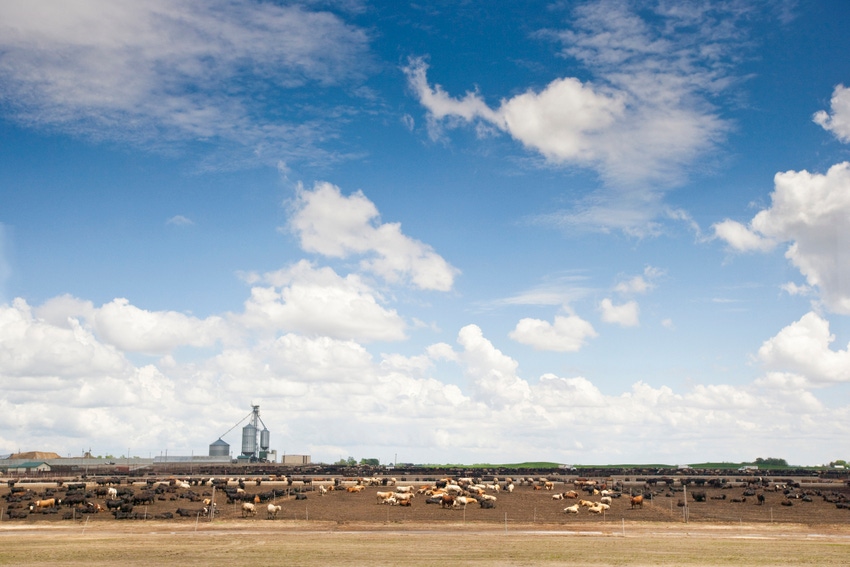Drought, improved margins and cattle availability likely contributed to rise.

The U.S. Department of Agriculture “Cattle on Feed” report showed that cattle inventory in feedlots a with capacity of 1,000 head or more totaled 11.4 million head on Sept. 1, 2020, a 4% increase above the same period last year. This was the highest Sept. 1 inventory since the series began in 1996, USDA noted. Analysts had expected a 3.5% rise over September 2019.
Placements in feedlots came in higher than the average pre-report trade estimate. The report showed that placements during August totaled 2.06 million head, 9% above 2019. Although analysts had anticipated that the report would show a higher placement number, they expected only a 6% increase.
Net placements were 2.00 million head. During August, placements were: 405,000 head for cattle and calves weighing less than 600 lb., 335,000 head for those weighing 600-699 lb., 470,000 head for those weighing 700-799 lb., 522,000 head for those weighing 800-899 lb., 230,000 head for those weighing 900-999 lb. and 95,000 head for those weighing 1,000 lb. and greater.
Marketings of fed cattle during August totaled 1.89 million head, 3% below 2019, which was in line with pre-report estimates.
“Despite the fact that returns for cattle feeders during August were negative, they were still putting large numbers of animals on feed,” USDA livestock economist Shayle Shagam said.
One possible reason for the larger numbers, he said, is the area experiencing dryness in the West, which may have encouraged some producers to place cattle.
Steiner Consulting Group (SCG), in the CME “Daily Livestock Report,” echoed Shagam’s sentiment that dry conditions likely contributed to some of the increase in placements.
“Cattle placements in Kansas were up 100,000 head, or 23% higher than a year ago,” SCG reported. “Drought conditions in western Kanas deteriorated sharply in August, forcing some feeders off pastures.”
Placements in Nebraska were up 13%, which SCG suggested was due to lower-than-normal placement rate in the previous three months.
An improvement in feedlot margins and the availability of cattle that should have been placed earlier this year were also partly responsible for the rise in placement, SCG added.
Meanwhile, Shagam noted that the backlog of feedlot cattle is being worked through, although the percentage of cattle on feed for more than 150 days is still larger than it was before the COVID-19 pandemic emerged.
Report likely to be bearish
Oklahoma State University Extension livestock marketing specialist Derrell Peel said reaction to the latest report is likely to be bearish. However, he said some perspective is important to understand the current feedlot situation.
“Obviously, 2020 has been a strange year, with unusual dynamics,” Peel said. “Despite large placements the past two months, total feedlots placements are down 4.2% for the year to date. Two months of large placements does not mean that we suddenly have more cattle.”
He explained that over the course of the year, the total number of feeder cattle in the pipeline has not changed from what was indicated early in the year.
“Cattle inventories peaked in 2019, and Jan. 1 estimated feeder supplies were down 0.4% year over year. As we work through 2020 and into 2021, feeder cattle supplies should continue to tighten modestly. The indications are that September placements will not follow the pattern of July and August,” Peel said.
However, he said this does not mean that the current dynamics are without consequence.
“While the long-term totals have not increased, the unusual fluctuations in placements imply more short-term dynamics in the next few months,” Peel said.
The higher July and August placements suggest that feedlot marketings will be larger in the first quarter of 2021, he explained, adding, “July placements were skewed to the lighter-weight cattle, while August placements included more heavyweight placements, which further implies that cattle could be somewhat bunched up.”
Since winter weather typically spreads cattle out a bit, he said the exact timing is uncertain, but “the ripples from the first half of 2020 will extend into early 2021.”
About the Author(s)
You May Also Like



.png?width=300&auto=webp&quality=80&disable=upscale)

